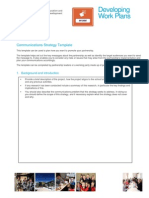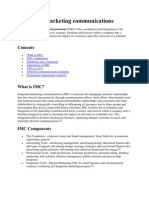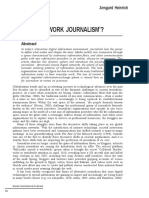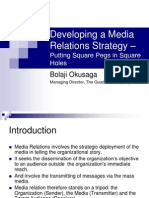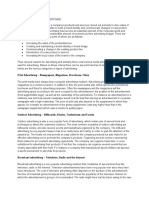Developing A Media Relations Plan PDF
Developing A Media Relations Plan PDF
Uploaded by
Flor HartridgeCopyright:
Available Formats
Developing A Media Relations Plan PDF
Developing A Media Relations Plan PDF
Uploaded by
Flor HartridgeOriginal Title
Copyright
Available Formats
Share this document
Did you find this document useful?
Is this content inappropriate?
Copyright:
Available Formats
Developing A Media Relations Plan PDF
Developing A Media Relations Plan PDF
Uploaded by
Flor HartridgeCopyright:
Available Formats
Developing a Media Relations Plan
The media can play an important role in helping to maximize the impact of your traffic safety outreach
efforts. In order to make sure that your interaction with the media is done cohesively and succinctly, not
randomly or without direct purpose, the development of a comprehensive media relations plan is
essential.
The purpose of a media relations plan is to help you take a step back, look at the big picture of how to
interact with the media and then proceed with clarity and purpose. There are several components to
any successful media relations plan. Creating a plan will help you and your organization stay on track
and be more direct in working with the media.
Media Relations Plan Components:
Situational Analysis The first step in creating a media plan is to analyze your current situation or
environment. Conducting a situational analysis will allow you to thoroughly examine the history,
background and potential obstacles facing your issue or cause. This analysis also enables you to
determine any positive or negative information about your external or internal environments. For
example, if you are trying to promote seat belt compliance among teens, it will be important to ask the
following questions:
What is the current compliance rate? How does it compare to the seat belt use rate of adults in
California?
What are the common characteristics of those teens not wearing seat belts?
Are there any existing programs in your area focusing on the issue? If not, when was the last
program implemented? Was it successful?
Will your audience be accepting of messages or not?
Goal What is the overarching end result you wish to achieve? In keeping with the above example,
your goal might be to increase awareness about the importance of seat belt usage by generating news
stories or it might be even broader increasing teen seat belt compliance in your county by three
percentage points within a specific time frame. The goal will provide the direction that your media
relations strategy will take.
Objectives Media relations objectives relate directly back to your identified goal and should be
measurable. They represent how you will meet your overarching goal. Objectives that would directly
support the goal of increasing safety belt use could be:
Generating positive awareness of the importance and life-saving benefits of seat belt
compliance through broadcast, online and print media stories
Increase visibility of your organization through media relations (i.e., increasing calls to your
organization)
Target Audience Identifying specifically who you are trying to reach will help in developing key
strategies and what tactics (actual actions) will work best. Audiences can be the news media
themselves, policy makers, community leaders or the general public. Often target audiences are
broken down even further children, parents, teens. If you are conducting an ongoing campaign
about the dangers of impaired driving, your primary target audience would likely be comprised of the
following groups of people:
Motorists
Repeat offenders
Men, 18-34 years of age
Secondary target audience members might include policy makers and community leaders in an
effort to engage them in the topic.
Strategy Development Now that your goal has been identified, its time to develop your strategy
your approach in meeting your goal and objectives. Strategies are not specific tactics, but rather they
represent the who and what and the how of meeting your stated objectives. For example, if your
objective is to generate more news coverage for your program, a strategy might be to foster
relationships with appropriate reporters. The tactics within the strategy might be a news conference,
letter to the editor or regular news releases.
Key Message and Story Angle Development The first step in developing your story for media
consumption is identifying the key messages you want to communicate to your target audience. What
message do you want people to remember? Are you asking them to become aware of an issue, alter
their opinion or change their behavior? By narrowing down your focus, and repeating your key
messages often, youll have better success in reaching your audience.
Once you have determined your key messages, its important to develop your media angle or hook.
What is it about your program or event that makes it newsworthy, links it to the community or affects
the public? Is there a current trend affecting your issue? The more you can simplify the message, the
more likely your chances for success.
Tactics Tactics are specific tools used or actions taken to reach your target audience(s) and assist
you in meeting your goal. Tactics always flow directly from your stated objectives and goal and they are
never done simply for the sake of doing something. They are done with a specific intent and end-goal
in mind.
Media relations is one tactic from a long list of communication disciplines. All of the sample media
relations tools you will find in this media resource guide are different media relations tactics (news
release, media advisory, news conference, etc). Which tactic(s) you use will, again, be based on your
overarching goal and your identified target audience. For example, if you are trying to encourage the
use of bicycle helmets among children of a specific ethnic population, the tactics used to communicate
your message will be very different than if you were trying to reach adult men with anti-DUI messages.
The channels through which these two groups receive information are likely to be very different.
Media List Development Lastly, it will be important to create an updated, comprehensive media list
to help in distribution of your media materials. Please see Media Relations Tools & Techniques, for
more information.
You might also like
- ST Mungo's Communications Strategy 2017-21Document8 pagesST Mungo's Communications Strategy 2017-21Alan SultanNo ratings yet
- Press Release TemplateDocument2 pagesPress Release TemplateJocelyn MartensonNo ratings yet
- 3 Crisis CommunicationsDocument15 pages3 Crisis Communicationsrahuln181No ratings yet
- Assignment 3 - Rhetorical Analysis of Advertising and EnvironmentDocument2 pagesAssignment 3 - Rhetorical Analysis of Advertising and EnvironmentLondie T. MartinNo ratings yet
- Guidelines For The Development of A Communication Strategy: Matthew Cook Caitlin Lally Matthew MccarthyDocument15 pagesGuidelines For The Development of A Communication Strategy: Matthew Cook Caitlin Lally Matthew Mccarthyolika100% (1)
- Evaluating PR Campaigns: Unit 6: Understanding Public Relations Campaign PlanningDocument6 pagesEvaluating PR Campaigns: Unit 6: Understanding Public Relations Campaign PlanningAnastasia StefanNo ratings yet
- Public Relations Unit 1Document4 pagesPublic Relations Unit 1Krrish virgotra100% (1)
- Unit 3:: Public Relations PlanningDocument19 pagesUnit 3:: Public Relations Planningroj sharmaNo ratings yet
- Developing A Communication StrategyDocument19 pagesDeveloping A Communication StrategyAyush KumarNo ratings yet
- Master The Media: The Step-By-Step Guide to Elevating Your Brand On Air, On Camera and On StageFrom EverandMaster The Media: The Step-By-Step Guide to Elevating Your Brand On Air, On Camera and On StageNo ratings yet
- Basics of Corporate CommunicationDocument17 pagesBasics of Corporate CommunicationAce LunariderNo ratings yet
- What Is A Press Release?Document11 pagesWhat Is A Press Release?Hrids WarrierNo ratings yet
- A Guide To Media RelationsDocument18 pagesA Guide To Media RelationsMåurå Mogeni100% (1)
- Public RelationDocument26 pagesPublic RelationManish Singh ChauhanNo ratings yet
- Strategic Communication and Social MediaDocument8 pagesStrategic Communication and Social MediaOana VarvaroiNo ratings yet
- Multimedia in Journalism PDFDocument12 pagesMultimedia in Journalism PDFMs. Suruchi AgrawalNo ratings yet
- Social Media For Crisis ManagementDocument37 pagesSocial Media For Crisis ManagementAllan Van Der TannNo ratings yet
- Communication StrategyDocument23 pagesCommunication StrategyRishi AgnihotriNo ratings yet
- 2 LECTURE Creative Strategy Planning and DevelopmentDocument45 pages2 LECTURE Creative Strategy Planning and DevelopmentcutechanchalNo ratings yet
- Corporate Communication StrategiesDocument23 pagesCorporate Communication StrategiesMouyad SrNo ratings yet
- Communication Strategy - Preview: Strategic Communication Is Based On Four Interactive VariablesDocument44 pagesCommunication Strategy - Preview: Strategic Communication Is Based On Four Interactive VariablesimchitraNo ratings yet
- TYBMS 141 Media Planning and ManagementDocument9 pagesTYBMS 141 Media Planning and Managementadee dhumalNo ratings yet
- Developing Work Plans: Communications Strategy TemplateDocument7 pagesDeveloping Work Plans: Communications Strategy TemplateErin DelgadoNo ratings yet
- Media Relations: Assignment - 1Document12 pagesMedia Relations: Assignment - 1shilpa mandalNo ratings yet
- Crisis Communication1Document22 pagesCrisis Communication1Maria Pilar ParreñasNo ratings yet
- Strategic Communications Plan Template: You Gotta Have A PlanDocument5 pagesStrategic Communications Plan Template: You Gotta Have A PlanTim FultonNo ratings yet
- Communications and PR Toolkit Part1Document13 pagesCommunications and PR Toolkit Part1Cameron100% (2)
- Press ReleaseDocument58 pagesPress ReleaseSilent StarNo ratings yet
- Integrated Marketing CommunicationsDocument5 pagesIntegrated Marketing CommunicationsAkshay KalraNo ratings yet
- What Is Network Journalism'?Document8 pagesWhat Is Network Journalism'?Adriana BarsottiNo ratings yet
- Appeal To Your Customers With Effective Ad CopywritingDocument21 pagesAppeal To Your Customers With Effective Ad CopywritingChaitu BablooNo ratings yet
- Strategic Planning For Public RelationsDocument28 pagesStrategic Planning For Public RelationsMs. JoyNo ratings yet
- Unit 4 Public Relation CampaignsDocument48 pagesUnit 4 Public Relation Campaignsroj sharmaNo ratings yet
- Creative Strategy DevelopmentDocument13 pagesCreative Strategy DevelopmentKameswara Rao PorankiNo ratings yet
- Media Relations StrategyDocument18 pagesMedia Relations StrategyBolaji Okusaga100% (2)
- Cadbury Crisis in IndiaDocument6 pagesCadbury Crisis in IndiaKushagra VarmaNo ratings yet
- Different Types of AdvertisingDocument2 pagesDifferent Types of Advertisingparuljain2503No ratings yet
- Communications Planning TemplateDocument7 pagesCommunications Planning TemplateInes Benvenutta KhoziNo ratings yet
- Notes For MP&BDocument80 pagesNotes For MP&BAmit Sanjay Gupta75% (4)
- Media Plan AssignmentDocument5 pagesMedia Plan Assignmentpooja agnihotriNo ratings yet
- WWF Communications Strategy Template T 1Document6 pagesWWF Communications Strategy Template T 1clyo72No ratings yet
- Corporate Communication ManagementDocument29 pagesCorporate Communication ManagementAkshaya Kumar0% (1)
- MC 645 Media Relations PlanDocument11 pagesMC 645 Media Relations Planapi-280475864No ratings yet
- Communication StrategyDocument42 pagesCommunication StrategyAfu Anish shakyaNo ratings yet
- Interview Techniques 3-08Document8 pagesInterview Techniques 3-08SCRBDusernmNo ratings yet
- Measuring Media Coverage EffectivelyDocument9 pagesMeasuring Media Coverage EffectivelyAsif KhanNo ratings yet
- PR Roll During Crisis. Four Step PRPDocument9 pagesPR Roll During Crisis. Four Step PRPidoc716No ratings yet
- SC1L StrategicCommIDocument16 pagesSC1L StrategicCommISiddharth MishraNo ratings yet
- Chapter 7 Designing and Managing IMCDocument76 pagesChapter 7 Designing and Managing IMCNegosyo Center LaoagNo ratings yet
- Creating A Communication PlanDocument2 pagesCreating A Communication PlanMr.SD100% (1)
- IMC - Final Ad Campaign Paper OfficialDocument23 pagesIMC - Final Ad Campaign Paper OfficialHalea_MacNo ratings yet
- PR ProposalDocument7 pagesPR ProposaldianahusseNo ratings yet
- The PR Practitioner's Desktop Guide AjcDocument266 pagesThe PR Practitioner's Desktop Guide AjcTao Huyen TrangNo ratings yet
- Advertising Design TheoriesDocument23 pagesAdvertising Design Theoriesm_dattaias100% (3)
- Integrated Marketing Communications (Imc)Document27 pagesIntegrated Marketing Communications (Imc)api-291598576No ratings yet
- 6 Traits Rubric For Descriptive Writing For "Guess The Object" ParagraphDocument2 pages6 Traits Rubric For Descriptive Writing For "Guess The Object" ParagraphTorres Ken Robin DeldaNo ratings yet
- A Guide To Effective Political Communication in Cameroon: Running For OfficeDocument76 pagesA Guide To Effective Political Communication in Cameroon: Running For OfficeLukmanNo ratings yet
- Intro To Comm MediaDocument28 pagesIntro To Comm MediaCarleenNo ratings yet
- BAJC2021 Basics of New Media - 1 (A) PDFDocument15 pagesBAJC2021 Basics of New Media - 1 (A) PDFMs. Suruchi AgrawalNo ratings yet






















